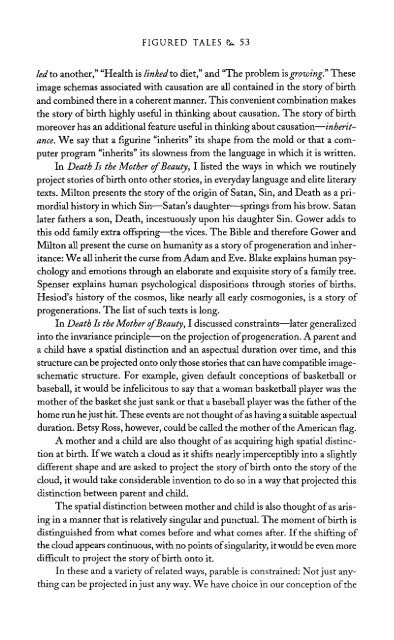The Literary Mind.pdf
The Literary Mind.pdf
The Literary Mind.pdf
Create successful ePaper yourself
Turn your PDF publications into a flip-book with our unique Google optimized e-Paper software.
FIGURED TALES 53<br />
led to another," "Health is linked to diet," and "<strong>The</strong> problem is growing." <strong>The</strong>se<br />
image schemas associated with causation are all contained in the story of birth<br />
and combined there in a coherent manner. This convenient combination makes<br />
the story of birth highly useful in thinking about causation. <strong>The</strong> story of birth<br />
moreover has an additional feature useful in thinking about causation—inheritance.<br />
We say that a figurine "inherits" its shape from the mold or that a computer<br />
program "inherits" its slowness from the language in which it is written.<br />
In Death Is the Mother of Beauty, I listed the ways in which we routinely<br />
project stories of birth onto other stories, in everyday language and elite literary<br />
texts. Milton presents the story of the origin of Satan, Sin, and Death as a primordial<br />
history in which Sin—Satan's daughter—springs from his brow. Satan<br />
later fathers a son, Death, incestuously upon his daughter Sin. Gower adds to<br />
this odd family extra offspring—the vices. <strong>The</strong> Bible and therefore Gower and<br />
Milton all present the curse on humanity as a story of progeneration and inheritance:<br />
We all inherit the curse from Adam and Eve. Blake explains human psychology<br />
and emotions through an elaborate and exquisite story of a family tree.<br />
Spenser explains human psychological dispositions through stories of births.<br />
Hesiod's history of the cosmos, like nearly all early cosmogonies, is a story of<br />
progenerations. <strong>The</strong> list of such texts is long.<br />
In Death Is the Mother of Beauty, I discussed constraints—later generalized<br />
into the invariance principle—on the projection of progeneration. A parent and<br />
a child have a spatial distinction and an aspectual duration over time, and this<br />
structure can be projected onto only those stories that can have compatible imageschematic<br />
structure. For example, given default conceptions of basketball or<br />
baseball, it would be infelicitous to say that a woman basketball player was the<br />
mother of the basket she just sank or that a baseball player was the father of the<br />
home run he just hit. <strong>The</strong>se events are not thought of as having a suitable aspectual<br />
duration. Betsy Ross, however, could be called the mother of the American flag.<br />
A mother and a child are also thought of as acquiring high spatial distinction<br />
at birth. If we watch a cloud as it shifts nearly imperceptibly into a slightly<br />
different shape and are asked to project the story of birth onto the story of the<br />
cloud, it would take considerable invention to do so in a way that projected this<br />
distinction between parent and child.<br />
<strong>The</strong> spatial distinction between mother and child is also thought of as arising<br />
in a manner that is relatively singular and punctual. <strong>The</strong> moment of birth is<br />
distinguished from what comes before and what comes after. If the shifting of<br />
the cloud appears continuous, with no points of singularity, it would be even more<br />
difficult to project the story of birth onto it.<br />
In these and a variety of related ways, parable is constrained: Not just anything<br />
can be projected in just any way. We have choice in our conception of the















